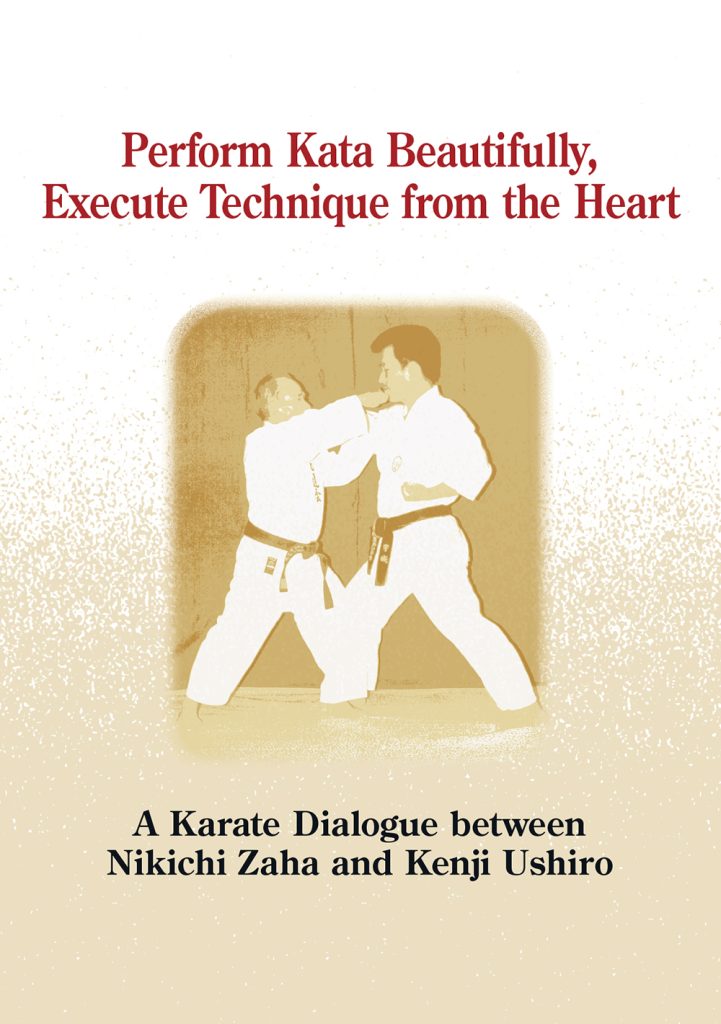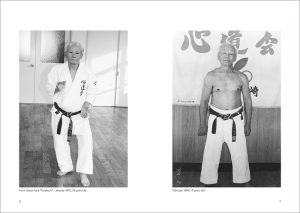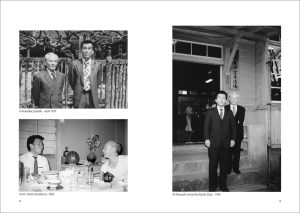Perform Kata Beautifully,
Execute Technique from the Heart
Nikichi Zaha and Kenji Ushiro
(A5 / 176 pages) 3,080JPY
ISBN: 978-4-910001-47-0
The dialogue is comprised of six separate interviews which took place January, 1993; July, 1994; March, 2000; August 2001; October, 2001 and October, 2002. The first interview took place when Zaha Sensei was 78 years old and Mr. Ushiro was 44 years old. The last one occurred when Zaha Sensei was 88 years old and Mr. Ushiro was 53 years old. Over nearly a decade, they shared their passionate thoughts on karate, resulting in the valuable historical record contained in this book.
It conveys the deep trust between Zaha Sensei and Mr. Ushiro, as master and disciple that has never wavered. Simultaneously, it unfolds a wealth of insights not limited to karate but extending to various aspects of life and existence: the history of karate and Okinawa, the essence of bujutsu karate, what it is to learn from a master, nurturing disciples, and ultimately, how one should live and exist as a human being.
Thoughts from Kenji Ushiro Sensei in publishing "Ushiro karate" and "Perform Kata Beautifully, Execute Technique from the Heart"
Reading these two books, I am reminded that the essence of what was said more than 20 years ago has not in any way changed. On the contrary, it feels alive and fresh. Change is absolutely necessary for progress and growth. However, no matter how much change there is, if the essence of that change is not consistent, the destination of that “change” will be completely different.
In my case, through Zaha Karate, I found the “reason” in the depth of the techniques at the same time.
It is obvious that if I had been doing sports karate and pursuing competitive karate since that time, I would not have reached the same state of mind as I have now. I realize that it is precisely because I did karate, which is not about winning or losing, but about moving in the direction of “winning oneself,” that I have been able to make the changes that have brought me to where I am today. This is exactly what I feel when I read this new book.
Progress and growth are about change.
To change is to know depth.
To know depth is to be humble.
This is the process of “change”.
In other words, it is progress, growth, and change toward depth.
It is the “change” brought about by the martial arts, which in a sense is related to the roots of Japanese culture. These two books are the result of examining and devising a specific way of practicing martial arts to achieve this change, especially in light of the practice of “jiri-itchi” (unity of purpose and reason).
I hope that the changes I have seen over the past 20 years in these two books will help as many people as possible learn, whether they are practicing karate or not.
contents
Gravure 16 pages (including unpublished photos)
Preface
■Chapter 1
Perform Kata Beautifully,
Execute Technique from the Heart
From Ryukyu-te to Karate across Styles
Historical lineage of Ryukyu-te
Limitations of performing kata in groups
Zaha The limitations of kata.
Karate that sees the mind-heart
Bushido in Ryukyu
Letting the other person’s breathing match your own
It is not good to keep techniques and kata locked away
Throwing techniques
varied applications from a single technique
The difference between waza (technique) and jutsu
Transferring the opponent’s power
Create a jutsu that suits you
Karate training with a Japanese sword (Shinken) in mind
A punch where the wind pressure goes first
Win without fighting
Bare hands and weapons
The power to change oneself
Eyes of the Mind-Heart
Win without fighting
Change from Recognition to Unconsciousness
Budo that transmits energy to the world
Karate came naturally to me as both my father and brother were karate practitioners
Shuri-te, Naha-te, Tomari-te
Karate practice for actual fighting
Create your own techniques with ingenuity
Teaching should be done seriously for each student
Mind-heart and technique united in Shindo-ryu
With the power to change the budo world
■Chapter 2
Tason-Jishin(outer respect, inner confidence)
Zaha Sensei’s Karate
Techniques come forward
Wife of Sokon Matsumura, a female karate practitioner
Practice in the dark--until the shadows flee and disappear
You can’t make use of your own technique without mastering the ability to ‘see.’
Fighting when you are cornered and winning without fighting
Believe in yourself that your technique is effective
Your karate is like an adult’s
Ongyoku, songs with musical instrument accompaniment, are an Etiquette of Ryukyu Bushi
The difference between striking and punching
Serious Practice is the driving force
Bujutsu kata is a perpetual art
Kata that creates the classics
Weight of kata
Do not execute with force, but show your technique
There are no words for instantaneous techniques
Watch and learn
From pretty (created beauty) to beautiful (true beauty)
Instantaneous judgment made by the forehead
Defense is Offense
Breathing
Relaxation is the secret of karate
One fist and a hundred different techniques
The Heart of Karate
Do not tarnish the name of karate
Use words that stimulate the brain
Make your own words with your own thoughts
The love between master and disciple is the key to developing one’s sk ills
Use this technique as a pillow
What it means to realize
The Heart of Karate: Winning without Fighting
Both the student and I practice together
Returning hardness with softness
■Chapter 3
The technique and mind of bujutsu karate
There is no age-related change in kata
Transform kata into forms and make it your own technique
A speedy fist is generated with breathing
Technique and mind-heart cannot be explained
Practice kata with clarity
What is the relationship between Dou and Technique?
---Respecting others while having self-confidence
Watching and looking
Perform Kata Beautifully. Execute Technique from the Heart.
This is the Beginning of Bugei
The art of life is to please others
Practice with vigor!
The more you lose, the better you become
Do not retreat. Advance
Kake-trial: Winning and losing are decided by the participants
The Three Principles of Karate--Ninjutsu, Medicine, and Arithmetic
Practice is not only in the dojo
Making Karate a Sport
Without ceasing to practice traditional karate
Teach and learn from your students
Afterword
Profile
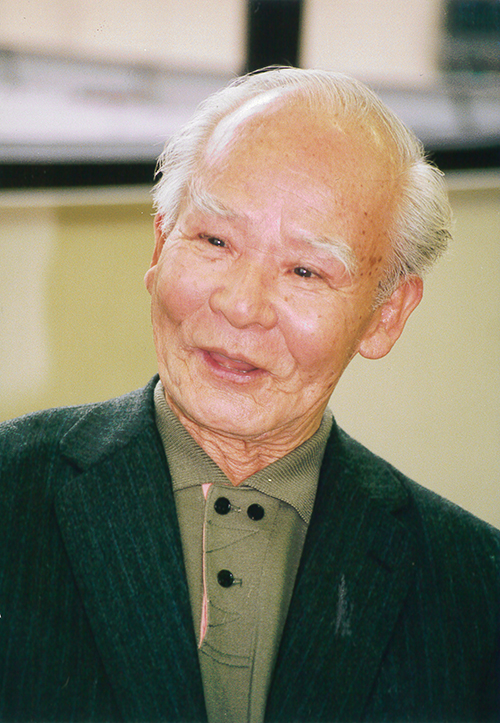
◎ Nikichi Zaha
from father and brother, Jiro, the latter a student of Asanobu Chibana, founder of the
school. In 1951, became Shihan of Karate Club of Miyazaki University. In 1973, changed
name of school to Shindo-ryu Karatedo Shindokai and has endeavored to preserve
karate as a martial art since then. Soke of Shindo-ryu Karatedo.
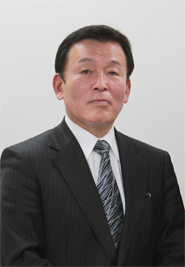
◎ Kenji Ushiro
Soshinkan Karatedo, 9th Dan, Hanshi
All Japan Kendo Federation Iai, Musojikiden Eishinryu, 7th Dan
Ushiro HQ Dojo, SoshinKan, Kancho
Kenji Ushiro was born on January 15, 1949 in Kobayashi city, Miyazaki, prefecture. In 1967, he entered Miyazaki University and joined the karate team.
He was the youngest entrant in the Second Annual National Karatedo Tournament.
He began direct training under Nikichi Zaha, master of Shindokai, after graduating from Miyazaki University.
In 1982, he was admitted to the All Japan Kendo Federation Iaido (Zen Nippon Kendo Renmei Iaido) and won over 50 championships in various tournaments.
He has been involved in the development of new technology for numerous electronic devices ranging from video equipment to satellite cell phones and has been granted many patents. He has also been a successful manager in the business world both domestically and internationally. All the while, he devoted himself to intense martial arts training and led a life of bunbu ryodo (unification of literary and martial arts).
He teaches actively in his own schools, Ushiro Karate Jissenjuku and Ushiro Dojuku, as well as at non-martial arts organizations including corporations, professional and amateur sports schools, high school baseball teams, among others.
He has expanded his practices and teaching overseas to the United States, Germany, Hungary, Italy, and Poland and has gained respect from the martial arts community all over the world.

